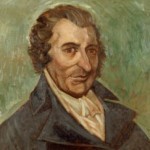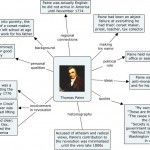
Thomas Paine is probably the most controversial figure of the American Revolution. A newly-arrived American, Paine’s writings during the tumultuous year of 1776 helped to kill off many of the lingering doubts about separation and independence. To some, Paine is the beating heart of the revolution – not just for his radical ideas about government, society and religion, but also how he expressed and communicated them. To others, Thomas Paine is a historical embarrassment, a figure obsessed with tearing down the old order to the point of destabilisation and destruction. Their Paine is ‘Mad Tom’, a crazy man, a leveler, the man who cheered on the French Revolution and encouraged its worst excesses. This division of views about Paine is reflected in popular and scholarly histories of the American Revolution. In some circles Paine is lavished with praise for his radicalism and his forthright pamphleteering. Some writers mention him only briefly – and many don’t mention him at all. Paine is especially ignored in American school textbooks, perhaps because of his alleged atheism, or perhaps because attention on Paine draws the focus away from better-known revolutionaries.
Paine was born in Norfolk, eastern England, in 1737 and received a decent education for the time. As a young man he tried his hand at several occupations – privateer, corset-maker, tax collector, schoolteacher and tobacconist – but Paine was not particularly good at any of them. By the time he was in his thirties, Paine was living in London and working for the government collecting excise and duties. He was also politically active, writing a long pamphlet about the mistreatment and poor salaries for excise-collectors. While in London he was introduced to Benjamin Franklin, complaining to the American about the lack of opportunities in Britain. Franklin encouraged him to emigrate to the American colonies, giving him a letter of reference. Within weeks Paine was crossing the Atlantic. It was a voyage which very nearly proved fatal: Paine contracted typhoid from contaminated water, and was half-dead when the ship docked in Philadelphia. It would take him more than a month to recover his health, after which Paine took a job editing a popular magazine. He acquitted himself well at this job, and became reasonably well-known on the streets of Philadelphia.
Bill Bryson, writer
Paine’s national fame came in January 1776, with the publication of the political pamphlet Common Sense. In this treatise on Anglo-American relations, a little under 50 pages long, Paine outlined the case for American separation and independence. Generally speaking, the ideas and arguments in Common Sense were not new; Paine was saying what many others were thinking. The only radical idea in the whole document was a grandiose vision of a vast American nation. “Common Sense imagined a continental empire at a time when Americans imagined isolated cities on separate hills”, as put by historian Thomas Slaughter. But it was the clarity and compelling tone of Paine’s rhetoric, not his ideas, that was critical. Unlike his contemporary polemicists, Paine avoided political theory, abstractions about rights and representation, references to the ancients or to little-known philosophers. He spoke in language that ordinary Americans could understand and used ideas and examples that they could comprehend. Common Sense therefore offered a much-needed connection between the ideology of revolution, and the masses who were struggling to understand why revolution was necessary. Among Paine’s themes and arguments were:
- An emphasis on America as a continent, and the absurdity of it being ruled by Britain, a small island.
- That America needed to separate itself from Europe, which was riddled with old hatreds, divisions and privileges.
- Condemnation of the concept of monarchy, highlighting its contradictions and querying the relevance and ability of absolutist kings.
- Attacks on hereditary succession and privilege, since one’s “descendants might be far too unworthy to inherit them”.
- An exploration of the relationship between society and government, which Paine argued was a “necessary evil”.
- A contention that independence would benefit America commercially and financially, rather than destroying her.
- At least twice Paine recommends a “continental conference” to construct and debate a written charter (constitution).
- Above all, Paine appealed to readers not to be swayed by tradition; he wanted them to break from history, not to be held captive to it.

Content on this page is © Alpha History 2015. Content created by Alpha History may not be copied, republished or redistributed without our express permission. For more information please refer to our Terms of Use.
